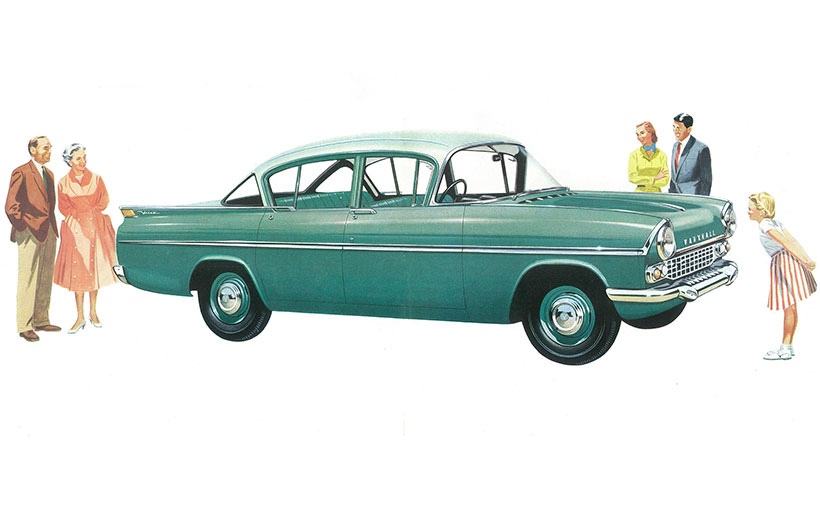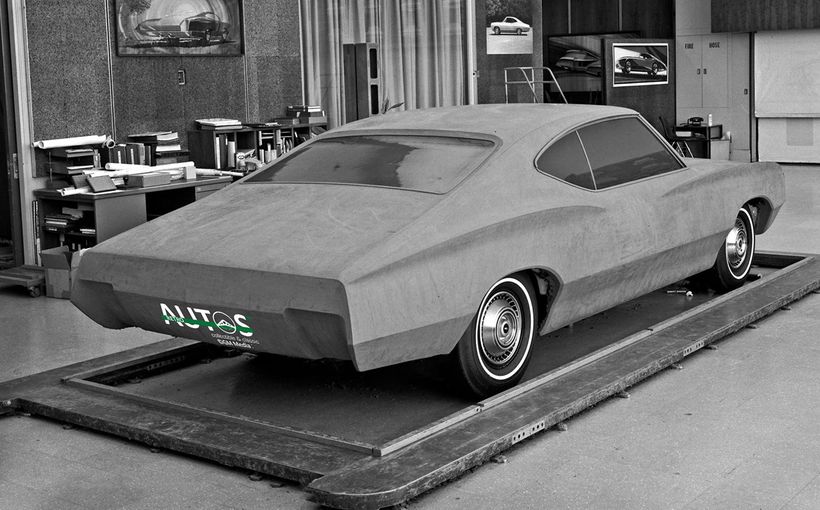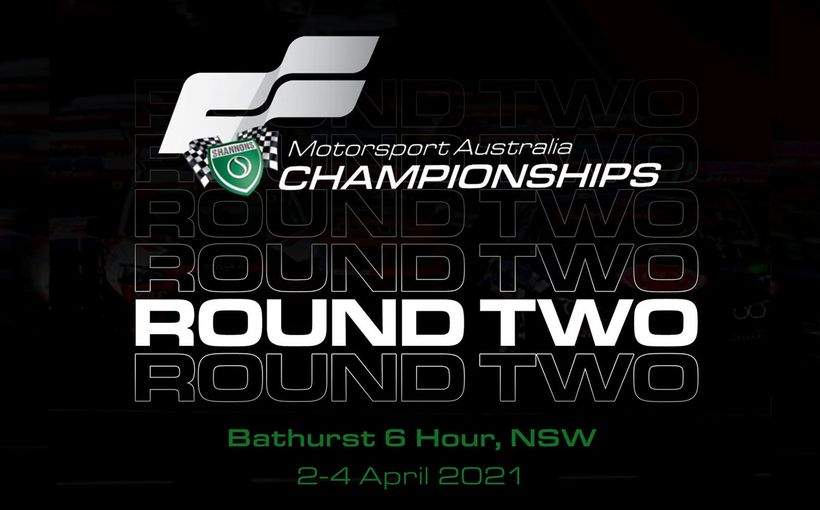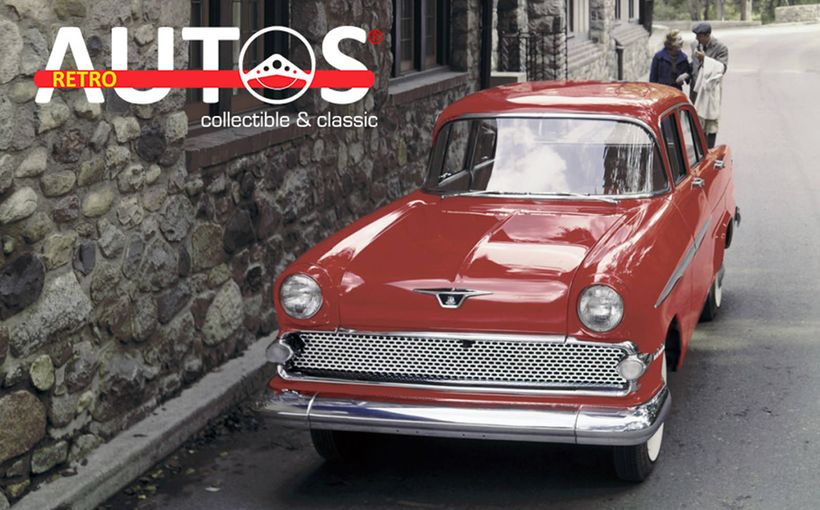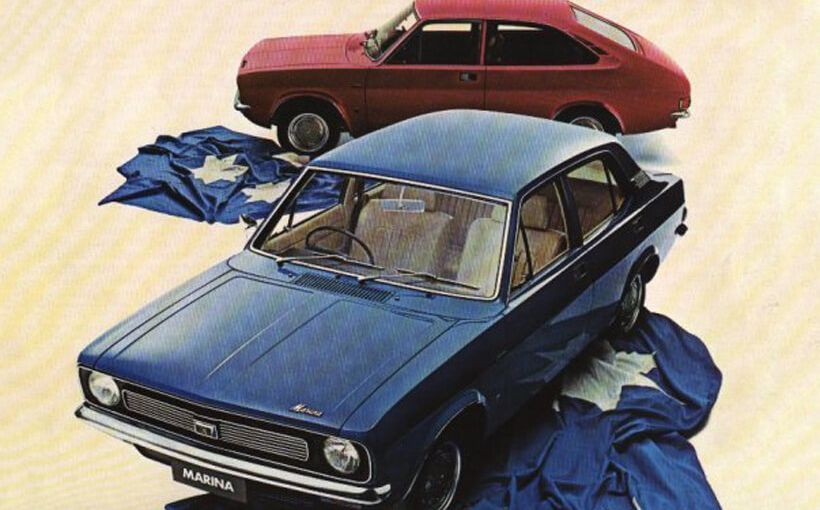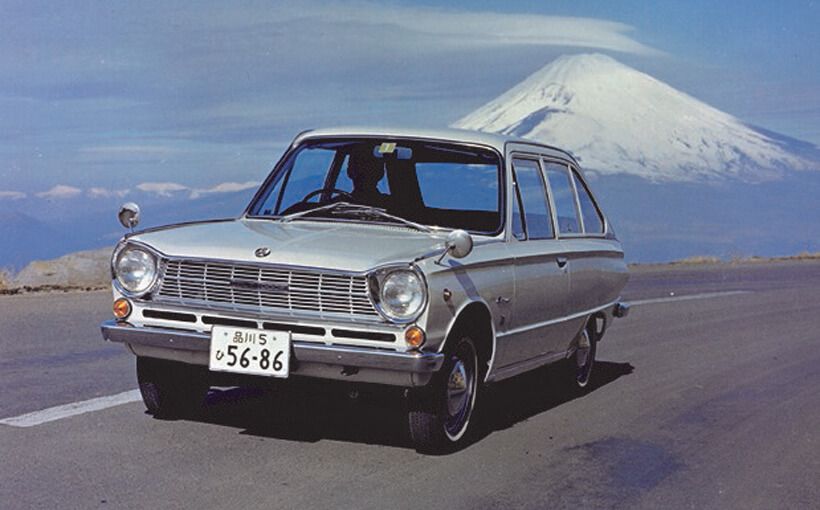1958-62 Vauxhall PA Velox/Cresta: Did Australians Still Need Holden?
By
JoeKenwright -
02 March 2015
Striking GM-H brochure shot of original 1958 Vauxhall PA Velox highlights down to earth advertising and sales pitch for its target market in Australia. Local positioning was almost the same as Holden with enough extra everywhere you looked to justify the price premium.
The GM-H launch of the Australian-assembled Vauxhall PA Velox in May 1958 makes no sense in today’s context. As a six cylinder family car, it shadowed the Holden in almost every dimension including engine capacity. By 1960, the facelifted Velox/Cresta range was far enough ahead of the retrograde Holden FB to make it redundant on a level playing field.
Except Holden kept the Vauxhall PA range alive for GM-H loyalists who didn’t want to join the one in two Australians who had purchased a Holden. It provided a more glamorous and exclusive alternative but only as long as cosy local assembly arrangements didn’t drop the price too low for it to be a threat to the Holden range. New rules that demanded extra local content and a procession of powerful new Holden Premier models then prompted Holden to consign the respected Velox/Cresta badges to history at the end of 1965.
Following the 1925 General Motors takeover of Vauxhall, GM’s British range played a critical role in keeping GM-H in Australia viable until the arrival of the first Holden.

Another no-nonsense factory shot from the GM-H brochure highlights how radical the roofline and the detailing, such as the door handles, were for 1958. Local dealer stamp is a reminder of the specialist GM-H dealer network that supported these new Vauxhalls along with locally assembled Chevrolet and Pontiac models.
After the end of World War II in 1945, this role became even more pronounced after British Commonwealth currency restrictions limited the availability of US vehicles and kept prices high. Compared to other British cars with their antiquated side-valve engines, local Vauxhalls with their simple Chevrolet-inspired overhead valve engines and compact size proved ideal for family buyers on a budget.
Although the first Holden leap-frogged anything produced by the British company in 1948, long waiting lists for the Holden ensured demand for a Vauxhall continued as an interim purchase.
In 1952, the Vauxhall E series with its early 1950s Chevrolet-inspired styling overtook the first Holden in styling and generational change. The 4-cylinder Wyvern and 6-cylinder Velox then gave buyers the choice between power and economy. They later proved useful in joining the Holden to head off the challenge from Ford’s British Consul and Zephyr ranges.
In the last year of the FJ, several inspired facelifts of the Vauxhall had delivered a Wyvern four priced the same as a Holden FJ Special while the Velox six commanded a 10 per cent premium.

Local GM-H brochure went to some lengths to highlight the extra vision in the PA Velox range. Australian country roads in 1958 certainly had their hazards but the PA cabin design gave you a better chance than most to spot them.
The arrival of the more modern
FE Holden in 1956 upset the Vauxhall and Holden pecking order. The FE featured styling a generation newer than the E series Vauxhall models. The FE made it harder to justify going backwards to a four cylinder Wyvern for the same money or paying extra for a dated six cylinder Velox.

This is the British factory pitch for the first PA Cresta. Post-war reconstruction delivered its share of comfortable self-made buyers who were in a hurry to tell everyone they had arrived. Vauxhall obliged. It was not as relevant for this buyer in Australia who could choose a tank Fairlane or Bel Air during this era.
PA Velox/Cresta – The Glamorous Trans-Atlantic Alternative
Like Holden, Vauxhall was precariously dependent on a single model line even if it did offer a choice of four and six cylinder engines. Unlike Holden, Vauxhall did not enjoy total domination of a protected domestic market.
The 1956 arrival of Ford’s Consul and Zephyr Mark II range highlighted how vulnerable Vauxhall was if its long model cycles were out of kilter with rivals.
A change in strategy was required. Because it involved funding the creation of two new Vauxhall ranges from scratch, GM in Detroit took a closer interest than usual.

Local market was prepared by the earlier appearance of the all new F series Victor which allowed the Velox/Cresta to stand alone as top shelf six cylinder models. Following a sales surge generated by its scale-model US styling, the model slumped under a poor reputation later partially restored by the much cleaner-looking facelifted version. (Photo from commons.wikimedia.org)
The first stage was an entirely new model called the Victor to replace the Wyvern. Presented as the F series, it was a standalone replacement for the Wyvern E series. Its US body styling positioned it as a 1957 Buick meets 1957 Chevrolet then crimped in a vice from all directions except height.
However, the Victor gave the British motorist, who wanted a taste of pure Detroit, a smaller and more manageable option. Its 1.5 litre engine was based on the Velox six minus two cylinders. Both shared the same bore and stroke. It was big enough for 1950s British roads.
The Victor had to share Australian roads with current full-size US models. On its late 1957 arrival, it was a novelty in the family four market and initial sales were better than the Velox. That lasted only as long as it took for the Victor to reveal its lack of development. It also rusted with unexpected haste.
Once the novelty wore off, it offered few of the redeeming features of the big US models yet it lacked the charm of a small British model. For Australians on a budget, it was more successful as a reminder of what they couldn’t buy. For those who made a point of buying British cars during this period to avoid US excess, it made little sense. Later Victor styling changes removed the US excesses and left it looking more like a smaller version of the current FB Holden. This broadened appeal and left the door open for Holden to persist with later Victors.

Unlike Holdens which tended to trail US styling trends, the PA Velox/Cresta featured glass, roofline and front treatment aligned with the current 1958 Chevrolet. Because both shared the same showrooms in Australia as six-cylinder models, it was a useful selling point for the more compact Vauxhall. (Photo from westchester-pa.americanlisted.com)
The PA Velox/Cresta evolved from a different process. No longer tied to an entry level Wyvern four, the next Velox/Cresta range could be presented as a more substantial six cylinder range. Early proposals were an unfortunate mix of European and US design trends that didn’t work. The production PB Velox/Cresta represented one of Vauxhall’s finest efforts under Vauxhall design chief Davy Jones who managed to hold the line between US flamboyance and British reserve, a balance missing in the first Victor.
For a 1957 British design, it reflected the very latest US design trends which placed it ahead of the older Zephyr Mark II and the FE Holden. Its curved roofline and wraparound front and rear screens previewed the 1958 Chevrolet and later proved to be more modern than the 1960-61 FB-EK Holdens at the end of its model life.
In the British context, the PA was an upmarket model for those who didn’t want to look like a banker or a doctor. It was perfectly timed for a new breed of British self-starters ready to break away from post-war austerity. As if to verify its authenticity, it quickly became a favourite with British “teddy boys” and rockers.
As a more modern unitary design than the Chevrolet, Vauxhall was careful to present the rear glass in three sections with extra struts that were an extension of the ribs in the roof.

This amazing photo highlights how low, sleek and modern the PA Velox/Cresta was compared to its facelifted Zephyr Mk II rival. The Brits loved this early car’s “mouth organ” grille but it was a little conservative in the Australian context especially when compared to the FC Holden’s more flamboyant front in 1958. (Photo from collectableclassiccars.com.au)
Like all British manufacturers with tough Commonwealth export markets like Australia and Africa, Vauxhall erred on the side of caution with the first of the series when it came to toughness. In terms of longevity and reliability, the PA Velox/Cresta was consistent with the Holden below it and the Chevrolet above it. And like both of its local stablemates, the PA Velox/Cresta was just as likely to be purchased by Australian families in the bush who expected it to work for a living, not just a show pony.
Scaled-down US glamour was no longer a novelty in Australia by 1958 as the real US cars were not only becoming more accessible, they were substantially bigger. “Big” Vauxhalls had to sell on merit in Australia, not size, as they weren’t so big in this context.

If you had one of these sitting in your front yard in Australia in 1958, you had every reason to be proud. The three-piece rear glass and ribbed roof were a facelift waiting to happen but there was not much wrong with the rest of it. (Photo from collectableclassiccars.com.au)
Although some aspects of the front styling also had 1958 Chevrolet design elements, the PA’s relative simplicity was more consistent with other British cars than US models.
British fans rate the original PA’s horizontal grille line between the headlights as the purest of all PA models. This “mouth organ” front, as it is sometimes called, was too conservative in the Australian context and the later curved grille models are remembered with greater affection.
However, the extra chrome detailing along the top of the front guards was a tasteful interpretation of the traditional Vauxhall bonnet flutes and remained until the end. This early PA also had side strips that were thicker at the front, also an acknowledgement of the traditional flutes, but these were simplified on later PA facelfts. The large oval tail lights and fins were quite spectacular even in Australia as they were bigger than both the Zephyr Mark II and the FE Holden.
It wasn’t just the styling that caught Australian attention. The roof profile was significantly lower than rivals and gave the PA a much sleeker appearance. It also highlighted the expanse of glass, great for vision, but not so good under the hot Aussie sun.
Key dimensions and specifications highlight what it brought to an Aussie party in 1958:
Vauxhall PA Velox (assembled by Holden): 1437 pounds incl tax new, 2262cc, 82.5bhp, 124 lbs/ft@1800rpm, 7in ground clearance, 105in wheelbase, 14ft 9 ½in length, 68.5 in width, front track 54in/rear track 54in, 0-60mph 17 secs, standing ¼ mile 20.5 secs, top speed 87mph, fuel consumption 23.1mpg, weight: 22.5cwt. Weight distribution: 56:44 fr:rear.
Ford Zephyr Mark II (second version): 1362 pounds incl tax new, 2553cc, 86bhp, 133 lbs/ft@2000rpm, 6.75in ground clearance, 107in wheelbase, 15ft ½ in length, 67 in width, front track 53in/rear track 52in, 0-60mph 16.9 secs, standing ¼ mile 20.2 secs, top speed 89mph, fuel consumption 23.5mpg, weight: 23.5cwt. Weight distribution: 56:44 fr:rear.
Holden FE Special: 1205 pounds incl tax new, 2170cc, 70bhp, 110 lbs/ft@1200rpm, 7.25in ground clearance, 105in wheelbase, 14ft 8 in length, 67 in width, front track 54.5in/rear track 54.5in, 0-60mph 21.2 secs, standing ¼ mile 22.0 secs, top speed 82mph, fuel consumption 26 mpg, weight: 21cwt. Weight distribution: 55:45 fr:rear.

The Vauxhall PA may have been conservative under the skin but the details impressed. Long inline six was recessed into the firewall and the fuel tank placed over the rear axle for better balance than usual. All the heavy bits were measurably lower than usual without cutting ground clearance. Its packaging was up to 10 years ahead of rivals even if the sleek styling generated more than its share of rust traps.
What these statistics don’t show is where the PA Velox was different. Although the PA was wider than both the Zephyr and Holden, its overall height was 3 inches/76mm lower than the Holden which helped disguise its slightly less favourable track versus width ratio. Its proportions were far sleeker than typically upright British cars which generated an impression of stability and speed, both backed by reality. In this area it was noticeably different to the Holden, which despite its height, still looked far more stable on the road than most cars of its size.
The PA cabin architecture positioned occupants in a more comfortable, semi-reclined position which placed a premium on leg room even if the actual measurements were similar. The transmission hump was also more intrusive as the transmission sat higher relative to the floor.
Although this reduced leg room for centre passengers, it generated a lower centre of gravity and eliminated the “sitting on a waving flagpole” effect that cars of this era would normally display. In Holden terms, the PA Velox had a far more modern feel on the road and gave Holden buyers a preview of what to expect when the EJ/EH Holden arrived.

The early PA dash with its extra gauges and padding was a big step forward over Holden dashes for years to come. (Photo from collectableclassiccars.com.au)
The dash was padded and the seats were a league ahead of the Holden park benches. Extra armrests on all doors and in the centre of the rear seat reinforced that step upwards over a Holden. Local testers lamented that a centre armrest was never offered for the front seat although it was a Cresta option in the UK. British PA Crestas could also be optioned with individual front seats on later models but not in Australia.
The Vauxhall PA was also the first of its type to offer synchromesh on first gear, a feature that beat Holden by at least 10 years. Its braking area was substantially ahead of Holden, a Holden weak point.
The clincher was a maximum speed in second gear of 58mph/93km/h, about the same as the Zephyr but a useful gain over the Holden’s 52mph/84km/h maximum. On narrow de-restricted roads, an extra turn of speed from a torquey engine could be a matter a life or death while passing the slow traffic that clogged the poor excuses for highways in 1958 Australia.
Talking of engines, the PA engine looked like a variation of the Holden grey engine as both reflected Chevrolet’s proven sixes. In reality, the Vauxhall was the expensive version, the Holden was the cheap version. Not only did the Vauxhall engine deliver more power and torque, its fuel economy was exceptional.
The better breathing head was the main difference but the Vauxhall’s short stroke design was the way of the future and more refined than the Holden’s long stroke design. The only sign of its early origins was the 2 gallon/9 litre sump capacity.

This Cresta was from the first PA facelift highlighting the new grille combined with the earlier indicators. It was this model that conquered the first Armstrong 500 but without this one’s desirable two-tone colour scheme. Even the whitewalls are correct but not this narrowband style which didn’t surface until 1962.
The PA’s Finest Hour
The PA’s first facelift, revealed in the UK in October 1959, almost went unnoticed in Australia on its March 1960 arrival. That changed overnight. And the main beneficiary was the Cresta.
A styling proposal for the front of the first PA model was dusted off after several more radical proposals from Detroit were rejected. The Davy Jones team linked the headlights with a curved grille bar leaving the new 1960 PA models with a big wide smile, backed by the practicality of a much bigger air intake. This new intake fed a big new radiator, an important advance for Australia as even Holden’s abstemious radiators could generate lines of stranded families along the highways on a hot summer’s day.

Because the 1960 facelift was based on a front rejected for the original 1957 model, it is fair to suggest that this 1956 Packard had some influence on how it looked. There are elements of this model’s side profile that showed up in the early Victor as well. (Photo from packardpanther.com)
The curved grille also highlighted the curves in the roofline and the curved sides which were almost a decade ahead of their time.
It also provided a major point of difference over the latest FB Holden which had a similar grille aperture to the earlier PA models and was generally regarded as a backward step over the FC it replaced. For Australians, the 1960 PA facelift brought back some of the glitter lost in the FC. It also provided a strong link to the last and most stylish Packards from the mid-1950s before they became Studebaker clones. But Vauxhall went much further.
The simplified side strips previewed an airiness and smoothness latent in the original body design. Gone were the roof ribs and struts that broke the PA rear screen into three pieces. Vauxhall had toughened up the rear parcel shelf, wheel arches and door pillars to provide the strength for a massive one-piece rear screen. Hot as it was under Australian conditions, it looked sensational and provided a fresh new context for the fins and oval tail lights.

Many claim that the clean one-piece rear glass of the 1960 facelift in combination with the earlier tail lights defined the most stylish of all PA models. Note the Cresta’s extra chrome around the side glass.
As the Rootes Group started applying a similar tail light design to its new models, the PA Velox and Cresta suddenly looked new again in their third year. The heater was upgraded and a new seat design along with a revised fuel tank location liberated an extra inch (25mm) of rear leg room, adding another reason to move above the Holden.
Mechanically, it didn’t change and didn’t need to as Holden went backwards. Despite a capacity increase which lifted the old Holden grey engine to the same 2262cc as the Vauxhall, the new FB’s horsepower was still pegged to 75bhp/56kW compared to 82.5bhp/62kW of the Vauxhall.
Not even Holden seemed to allow for the possibility that the poor design and extra weight of the FB had pushed the Holden even further behind the PA Velox/Cresta. At a time when the world’s manufacturers were reducing frontal area, Holden increased it.
The PA’s curved upper grille bar reduced the distance between the headlights and the grille and brought the Vauxhall range closer to the latest trend to place the headlights in the grille. It was a timely reminder that the PA range was much sleeker than a Holden at a time when the FB raised the headlights even higher above the grille (compared to its more modern-looking FC predecessor) and turned the clock back more than five years.

This 1960 Cresta’s leather-trimmed interior highlights the revised seat style and steering wheel. By 1960 standards, it still looked fresh.
The PA range at Cresta level could easily outrun the FB yet it offered carpets, magnificent leather seats and a range of other extras. The FB’s potentially lethal metal lip over its new dash compared to the padded Vauxhall dash top should have prompted most concerned family buyers to reach for their cheque-books for a top-up.
Vauxhall Cresta (assembled by Holden): 1541 pounds incl tax new, 2262cc, 82.5bhp, 124 lbs/ft@1800rpm, 7in ground clearance, 105in wheelbase, 14ft 10in length, 68.5 in width, front track 54in/rear track 54in, 0-60mph 17 secs, standing ¼ mile 20.1 secs, top speed 95.8 mph, fuel consumption 27.3mpg, weight: 22.5cwt. Weight distribution: 56:44 fr:rear.
Holden FB Special: 1247 pounds incl tax new, 2262cc, 75bhp, 120 lbs/ft@1400rpm, 7.25in ground clearance, 105in wheelbase, 15ft 1 ½ in length, 67 in width, front track 54.5in/rear track 54.5in, 0-60mph 20.8 secs, standing ¼ mile 21.8 secs, top speed 82.3 mph, fuel consumption 24 mpg, weight: 22.25 cwt. Weight distribution: 55:45 fr:rear.

This rear view of the 1960 Cresta cabin shows the extra rear legroom from re-positioning the fuel tank and a new rear seat design. Note the centre armrest also standard in the Velox.
As the above confirms, the FB had grown in length and weight with nothing to show for it inside except a slightly bigger boot. It had gained power and torque but was slower and thirstier than the FC it replaced. Although the FB’s brake lining area had grown from 96.6 to 112.5 sq in, it was still a long way short of the Vauxhall’s 138 sq in.
Holden really was starting to short change its buyers in 1960-61. The latest Vauxhall in GM-H’s own stable, which still carried some import duty because it was locally assembled not manufactured, had the potential to make Holden’s latest efforts look silly on a level playing field. The Vauxhall could now cruise effortlessly at the Holden’s top speed.
And this is exactly what happened after two wise men elected to take a Vauxhall PA Cresta to Philip Island for the first Armstrong 500, instead of an FB Holden. The fallout from this was massive after the Cresta unexpectedly emerged as the king of the survivors. Modern Motor and Melbourne Herald Road Tester Bryan Hanrahan drove the Armstrong 500 Cresta immediately after the race and couldn’t believe how strong and tight it felt. Despite the limitations of the three speed manual gearbox, it was quick for its day.
Hanrahan tells the story: “I’m not going to say a word about the ability of the Cresta suspension to take punishment. I’m still wondering how ANY car finished that 500-mile grind on that potholed – cratered is a better word – track without coming to pieces.” Hanrahan then went on to praise the quick and light steering and the flat and stable handling.

The PA boot was unusually deep and uncluttered even if the spare was under the floor. The fuel tank was at the front of the boot over the rear axle out of harm’s way on a number of scores including rear collisions or being holed by a rock on local unsealed roads.
Demand for the Cresta went through the roof which an embarrassed Holden struggled to meet. Norm Darwin’s book “100 Years of GM in Australia” notes that 2548 PA examples were sold in 1958, not bad for a May release. Sales of 3343 were recorded in 1959 before climbing to 3405 in 1960.
But that was nothing compared to what was coming…

This is the final PA series with the one-piece front indicator/park light units and extra chrome below the side glass. The extra 30bhp under the bonnet was a massive increase. The year of assembly can usually be pinpointed by the colours that aligned with Holdens. Note whitewalls on the grey car correct for a 1961 model.(Photo from Vauxhall Owners Club of Australia)
The King Hit that Should Have Killed Holden
As Australian eyes were on the first Falcon to see if it would wake Holden out of its slumber, the real contestant was coming down Holden assembly lines and sitting in local showrooms by February 1961. It could have been on Australian roads as early as September 1960.
In the same October 1960 Wheels issue which featured a special road report of the first local Falcon, there was also a detailed report of what was now coming down the British Vauxhall production line.
The 1961 model year Velox/Cresta had just been given a new engine boosted to 2651cc with a square bore and stroke of 82.55mm. A 17 per cent increase in capacity for an equivalent figure to the Holden HR’s 161 of 1966, it delivered similar power to the Holden HR after the compression ratio was raised from 7.8 to 8.1 to 1. Power climbed to a healthy 113bhp/84kWat 4800rpm (or just 2bhp short of the EH 179 that was still three years away) and torque climbed to a massive 148 lb/ft at 2400rpm. Previous figures were 82.5bhp/124lb/ft. A new clutch which was an inch (25mm) larger in diameter ensured that this extra grunt would reach the rear wheels without slip or falling apart.
More importantly, 130 of that 148lb/ft was available from just 1100rpm and could be relied upon to still be there as high as 4500rpm. This allowed a taller diff ratio (3.29:1 compared to 4.11) and bigger 14 inch wheels, which in turn allowed an inch (25mm) increase in front brake diameter. The 147sq in lining area exposed the FB’s 112.5sq in as being on the dangerous end of the scale.
A period description highlighted why the engine proved so long-lived: “The forged steel crankshaft runs in four main bearings and has a 7/16 inch overlap between main and big end journals. The pushrod-operated overhead valves lie in separate smooth finished ports and are of composite construction with wear resistant stems welded heat and corrosion resistant heads. Die-cast aluminium rockers operate without rocker shafts, on ball joints dowelled to the cylinder head. Combustion chambers are wedge-shaped. Pistons are tin-plated, with offset piston pins and chromium-plated top rings. The crankcase is ventilated with filtered air and vented to the carburettor air cleaner. For uniform cooling there is a coolant distribution duct inside the water jacket.”

Two end of series PA Crestas in single and two-tone Holden colours. Note the red Vagabond tourer between the Crestas and the cream Caleche tourer at the far end. These were GM-H factory chop tops with side curtains instead of glass for a cheap entry model. The PA series was spared from such treatment after Australian buyers tired of the body slop and the absence of wind-up side windows. (Photo from Vauxhall Owners Club of Australia)
Outside, the front indicator/park lights were integrated into one unit and headlights were sealed beam for the first time in the UK market. The rear lights were integrated into a single smaller unit which meant that the fins no longer ended with the rear indicators. The rear bumper was simpler and wrapped around at the sides.
Extra side strips were applied just below the side glass and continued below the fins. The whole effect was a surprisingly cleaner and more modern design without major sheet metal changes while allowing for a more intricate two-tone option.
Inside there were more changes to the seats and the dash was new with a horizontal speedo and a ribbon that replaced the needle. As the ribbon extended across the speedo calibrations, it changed in colour from green to amber to red as speed increased.
Local road tests discovered that the 1961 Velox/Cresta was an almost 100mph/160km/h motor car, a product of Vauxhall re-engineering it for new British motorways. For Australia, it was perfect for long distances, cruising faster at lower engine speeds. Even better was the price cuts which lowered the Velox price from 1437 to 1388 pounds and the Cresta sticker from 1541 to 1463 pounds. The Holden EK Special started at 1169 pounds but it too was cut back to 1110 pounds during this period such was the intensity of the new competition.
The standing quarter mile time dropped significantly to 19.4 seconds and zero to 60mph was just 12.5 seconds, a five second reduction. Second gear now peaked at around 62mph/100km/h. Fuel consumption didn’t change.
The Wheels tester noted that “General Motors-Holden’s attitude towards the Vauxhall seems to be rather calm compared with the high pressure of Holden selling.”
There was good reason for this. Holden had been caught with its pants down by the XK Falcon which had yet to reveal its weaknesses and the first Valiant was on the horizon. Holden could not afford to lose any more sales, least of all to its own Vauxhall range which came to Australia in CKD kits.
Holden had a giant and inefficient network of factories across Australia to keep ticking over. The EK was more of the same under-performing FB it was based on, with only electric wipers and Holden’s first automatic option to distinguish it. As a Hydramatic auto, the 1961 Vauxhalls made the new Holden EK version look feeble.

Final PA Crestas in the UK could be ordered with split front seats and the latest wood dash style with its padding colour-matched to the seats. Presentation was a preview of what was to come in the PB series. (Photo from southport.gb.com)
In the PA’s last year in 1962, it started to date against the crisp new Holden EJ except there was still no good news to be found under the Holden bonnet. For 1962, Vauxhall revised the dash again moving the ashtray from an in-dash drawer to the top of the dash, while adding padded sunvisors with clip retention and rear grab handles. Wipers were increased in length and the steering ratio was lowered before it was plucked out of harm’s way from the Australian market in early 1963.
The ageing PA, good as the final version was, would have struggled to fetch a premium against the latest Holden EH, the fresh Australian-built AP5 Valiant and a rapidly improving Falcon.

This rear view of the 1961-62 PA Cresta next to the 1960 model highlights how little Vauxhall would have spent to achieve the new look compared to the five Holden models over the same 1957-62 period. Endcaps replaced the full depth tail lights to support the smaller tail lights and the fins were re-worked as they no longer housed the indicators. Note the revised end sections added to the earlier rear bumper. Like most of Holden’s CKD models during this period, most dash items were finished in uniform grey or black and not tied to the trim or paint colour. (Photo from commons.wikimedia.org)
Velox vs Cresta: What did it all mean?
Previously, each badge in a Vauxhall range signalled a different car even if they looked the same. The Cresta badge was not only a break with Vauxhall tradition but an alignment with GM’s latest US practice which applied totally different names to the same car depending on equipment levels.
This didn’t apply to Holden until the EJ Premier arrived in 1962. Holden levels tended to be self-explanatory including Business, Standard and Special. The Holden transition to the US system was completed in 1968, after the HK Belmont, Kingswood and Premier became the new model sequence.
The PA Velox and Cresta shared the same sheet metal and mechanicals down to the last nut and bolt. For the UK market, it made sense to offer a hose-out family/business version called the Velox and a luxury version called the Cresta in 1958, similar to the Holden EJ Special and Premier.
Vauxhall applied typical US add-on upgrades to create the Cresta including various medallions and classier badging, extra chrome around the side glass, wheel trims, white wall tyres (broad band until 1962), leather or special cloth trim, carpet, integrated heater-demister, clock, windscreen washers powered by engine vacuum and cigarette lighter. Later PA Crestas were given fake wood accents around the cabin which, along with carpet, also appeared in the very last PA Veloxes.
Throughout the PA model life, there were several special Cresta colours including metallics.
As this trend consolidated, the British large car market wanted their hamburgers with the lot. Velox equipment levels had become so close to the Cresta that the Velox was dropped some years before the last PC Cresta was built.
The Australian market came from a totally different perspective. Just as the local
Chevrolet Bel Air had to be bolstered in specification above its US equivalent because of who bought it, the same happened with the PA range.
The PA Velox was upholstered in the Holden FE-FC Special’s high quality, long life Elascofab vinyl in a stitched pleated pattern covering premium foam rubber cushions. It also had practical rubber mats. Even at this level, it was priced well above a Holden Special but presented at the same level of trim. This is where the line became blurred.
Local Vauxhalls were usually sold through a special dealer network that also stocked the latest GM-H-assembled Chevrolets and Pontiacs along with the occasional RHD Buick and Cadillac import. Although Vauxhall wasn’t quite in the league of HSV, it was along that spectrum in sales volumes and special vehicle status. In fact, GM-H became increasingly reliant on the Vauxhall PA range in this market until Chevrolet and Pontiac restored some discipline to their 1961 ranges.
The Australian Velox driver was just as likely to be a Cresta buyer who didn’t want or need the upkeep of carpets or leather in the bush. After all, the Velox interior was aligned with the Holden Special, the top Holden at the time. Extra chrome and wheel trims were just more items to fall off or get damaged. Yet these buyers did appreciate the need for a factory heater-demister integrated into the ventilation system (as the Cresta’s was) and they certainly understood the need for windscreen washers.
Holden basically built both local models to the same standard in seating with different trim then left it to the dealers to add Cresta features to the Velox as required. Because the Holden colour range consisted mainly of solid colours for most of the PA model life, colours on both the Velox and Cresta tended to shadow the current Holden Special range.
After the FE, FC, FB, EK and EJ Holdens featured the broadest two-tone colour ranges on the Australian market at the time, the exterior presentation of the local Vauxhall PA range especially with Holden’s later Magic-Mirror acrylic finish was usually first-class. And like the Holden, rust protection was minimal.
In this context, the local PA Cresta could only ever find a limited market. It took the EJ Premier to nail the level of differentiation it needed over the Velox including leather bucket seats and metallic paint, both of which were available on later British models.

Holden launched the PB Velox/Cresta in plain solid colours that seemed to reinforce the drabness of the early PB models compared to the upbeat local EH. As seen here, Vauxhall added much needed bling to the PB range and a new 3.3-litre engine in 1964 but Holden was still committed to clearing the earlier version until 1966. (Photo from commons.wikimedia.org)
The local PB Cresta range made even less sense in the EH Premier context after it was again denied leather bucket seats and metallic colours. It is not surprising that GM-H was forced to skip the more glamorous 1964 PB facelift and its powerful new 3.3-litre engine as Holden was still clearing the last CKD kits of the earlier version in 1966.

As Holden launched the HD in Australia in 1965, Vauxhall was presenting the new PC Velox/Cresta range in the UK. Exactly why Holden didn’t present a Holden as crisp as this new Vauxhall with its strong links to the 1965-66 Chevrolet range isn’t clear. The most likely answer is because Holden had yet to treat its new rivals seriously. It took the XR Falcon to force Holden to redesign its HR replacement and match the PC Vauxhall in looks in 1968. Around 200 imported examples were sold in Australia. (Photo from gomotors.net)
Conclusion
The PA Velox/Cresta must be regarded as an unusually good car for a 1957 model after it shared showrooms with the FE, FC, FB, EK and EJ Holdens while maintaining a healthy lead over all of them.
Just as Vauxhall seemed to be making a better Holden, the PB Velox/Cresta which took over locally in April 1963 suddenly seemed dowdy by comparison. After the PA Velox/Cresta was saved by Detroit intervention and turned into a crisp and modern international model, the early PB Velox/Cresta range appeared to sink into British conservatism at the exact point when both the EJ and the EH had been freshened-up in the US.

Another view of the PC Vauxhall which also boasted a 3.3-litre engine that would have taken the battle to the XR Falcon in style and power in 1966. It also provided the context for the HB Viva/Torana seen in Australia. In many ways, it was also a more rakish design than the square-fronted HK Holden range.
Although Holden still had a long way to go before the handling and brakes of its own range were good enough for the EH’s powerful new red engines, Holden demonstrated that it still knew what Australians wanted. The PB Velox and Cresta bubbled along at a fraction of PA sales in Australia and overseas.
Yet by 1965 the HD had sent Holden backwards again except this time there was no Vauxhall PC Velox/Cresta, a striking take on the 1965-66 Chevrolet, in Aussie showrooms to highlight how far Holden had slipped. By 1972, Vauxhall had abandoned its big car models, by which point Holden had caught up in 1968 with the
HK range then overtaken it with the HT, HG and HQ.

The last remnant of Velox/Cresta DNA survived in this Leo Pruneau-designed Vauxhall Ventora, a Vauxhall six-cylinder variation of the theme represented in Australia by the LH Torana/Cortina 6/Centura 6. In several areas, it was better than all of them but for Opel, Vauxhall and Holden to keep producing three totally unrelated models in this size segment made no sense. The V-car Australians knew as the Commodore was the solution. All Australian Commodores from 1978 until 2006 were then derived from a shared Opel and Vauxhall model.
Vauxhall meanwhile had focused its efforts on a more compact family six, between Torana and Kingswood in size. It then took until 1978, 20 years after the PA Velox/Cresta launch, for Opel, Holden and Vauxhall to finally build variations of the same model from this market segment, the car Australians knew as the VB Commodore.

























